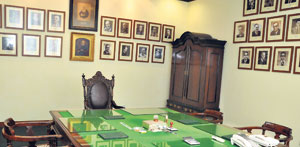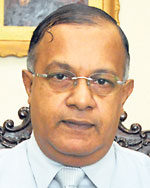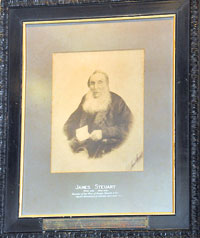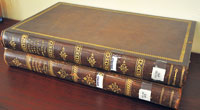
Portraits of chairmen over the years, adorn the wall of the office and below, finely-bound tomes of meticulously handwritten notes kept by James Steuart |
A chequered history not only with many a trial and tribulation but also numerous triumphs! Spanning a solid 175 years, this company believed to be the first merchant bankers of this country who later turned into an agency house and much later diversified to meet the many vicissitudes in its path, has weathered the bad times and faced the good times with equanimity.
What is the secret behind its survival and success? The answer is simple and reveals the strong foundations on which it has been built.
It’s the Steuartian grit and spirit, says Chairman J.M. Wimalagooneratne, seated in his plush office at 45, Janadhipathi Mawatha, Fort, across from the Central Bank, where this long journey -- reaching the milestone of 175 this year -- of George Steuart & Company Limited began way back in 1835.

Present chairman: J.M. Wimalagooneratne |
“For a business to continue this long, you must have the correct human resources and this is what has been passed down by our Founder James Steuart,” says Mr. Wimalagooneratne, who now occupies the revered chair of the head of the firm. In his office lie the finely-bound tomes of meticulously handwritten notes on varied topics including the events in Sri Lanka that James kept in true sailor-like tradition of maintaining a log.
Ironically, it was a serendipitous mistake that led Founder James Steuart to Ceylon. Sierra Leone, he thought, he was on his way to only to be told that it was Ceylon. James had been on a routine trip to Cape Town in 1814 as a Master in the British Navy when he thought he was told to undertake a voyage “to Sierra Leone”. However, when he was congratulated by a friend for agreeing to go to Ceylon that he realized to his amazement that he would be chartering unknown waters.

Portraits of founding father James Steuart (top) and George Steuart (above). Pix by Gemunu Wellage |
No challenge was too great and though he possessed no sea charts on the Indian Ocean, he not only looked up India in the Gazetteer but delved deep into the recesses of his mind for the geographical position of Ceylon he had copied when drawing the map of India at school.
Born at Dover in England, James was from a family with strong nautical traditions. He had apprenticed himself as a seaman to his father at the tender age of 15 in 1805, learning navigation for two years. Restless in spirit, he had then persuaded his father, though having served only two of the seven years of apprenticeship, to let him roam the South Seas on a whaler. Back in England, he took up the duty of commanding a transport vessel for His Majesty’s service between London and Lisbon, emulating his father’s services to the Crown, four years later being appointed a Master in the Navy.
On agreeing to come to Ceylon, he set sail for Galle arriving in this main port of call of that time on January 12, 1818. What he didn’t realize was that it would change the course of his life, while also having an impact on the economic affairs of this country. Handing over letters brought from Cape Town to the Master Attendant at Galle he set his sights on Colombo, being warmly received by the Master Attendant here and the English residents.
It was a time of turmoil in Sri Lanka as most of the British troops had been sent to the Kandyan districts to quell the rebellion. James, meanwhile, stayed with a merchant in Colombo who later recommended him as a “trustworthy man” to the Arbuthnots, the Agents to the Madras Government propelling him into the world of business and commerce. Incidentally, Robert Arbuthnot had been Colonial Secretary in Ceylon and his brother George Deputy Assistant Colonial Secretary before starting their family business.
 Life took on a routine for James shuttling between Colombo, Cape Town and England taking such cargo as coconut oil but once even Governor Robert Brownrigg and also transporting troops to Calcutta and Trincomalee.
A prolific and meticulous note-taker, he had once recorded that when his ship, dogged by storms, was forced to anchor at St. Helena, “Napoleon (detained there) refused to receive visitors but amused himself in his flower garden and gave his guards no trouble”. Life took on a routine for James shuttling between Colombo, Cape Town and England taking such cargo as coconut oil but once even Governor Robert Brownrigg and also transporting troops to Calcutta and Trincomalee.
A prolific and meticulous note-taker, he had once recorded that when his ship, dogged by storms, was forced to anchor at St. Helena, “Napoleon (detained there) refused to receive visitors but amused himself in his flower garden and gave his guards no trouble”.
Later James, the entrepreneur that he was, bought his own ship but sold it when offered the post of Master Attendant in Colombo by Governor Edward Barnes in 1825 to engage in the task of providing boats at fixed charges, maintaining a marine store and also repairing ships. But life was troubled, for James faced opposition from merchants as imports-exports rose while he also had to battle with a manpower shortage for the “Hindostan” men who handled cargo boats worked “only part-time in Ceylon and the balance in India with the Sinhalese not being accustomed to such work”. A further blow came in the form of the abolition of rajakariya (compulsory labour for the state) though James himself was an activist for such a move.
Little known and heeded details
4 One of the most magnificent bequests to the Church of England in the 1800s is believed to have been made by James Steuart – the house and property extending over 20 acres in Colpetty, part of which had later been sold by the church for the construction of St. Andrew’s Scots Kirk and also Hotel Lanka Oberoi, the current Cinnamon Grand Hotel.
4James Steuart was a liberal humanist cum radical who advocated adult suffrage for the Ceylonese, when they themselves opposed it; a territorially-elected Legislature in which divisive influence of race would not figure; that one-fifth of the colony’s resources should be devoted to education (a view unusual for that time); was a critique of the colonial government’s fiscal measures. |
The events in the country being inextricably linked to James’s fate, with the recommendation of the Colebrooke-Cameron Commission to abolish the government monopoly of cinnamon exports, the business literally fell into his lap when Arbuthnot and Co. in Madras urged him to collect the produce for them.
James’s debut into merchandising came when the company requested him to “keep a stock of these goods (cinnamon and coffee) with you to be either sold on the spot or shipped under specific instructions”, earning a commission on the business transacted.
But as he performed valuable services exporting cinnamon and coffee and importing bullion more troubles loomed – subtly but later openly, the merchants campaigning against him through the sole newspaper of the time, The Observer and Commercial Advertiser, alleging a conflict of interest in civil servants trading, although he was not a member of the Ceylon Civil Service. But Arbuthnot and Co stood behind him.
With authorities giving in to pressure, however, James was not only compelled to give up his trading activity but also wind down his business of maintaining boats in the Colombo Port, selling ship’s stores and undertaking minor repairs to ships.
Transferring his business to his brother Joseph who was Master Mariner at Dover, James left the renamed firm, Joseph Steuart and Company, and returned to England in 1855 a bitter man after dining at the Governor’s table on the Saturday and leaving Colombo forever on Monday….
conscious that I had done my duty, although my services were not appreciated”, for he had spent his last days in Ceylon on work at the pearl fisheries which too had been clouded by disappointment over the refusal to pay him even a small allowance.
But nearly a century later James’s services were recognized and commended by Trotskyite leader Dr. Colvin R. de Silva for doing yeoman service….. “preparing an accurate chart of the banks and studying the habits of the oyster” as Inspector of the Pearl Banks.
He also went back with a heavy heart because six years earlier he had buried his wife, Ann, at the Galle Face cemetery….in “the Cinnamon Isle where sleeps the beloved partner of my happiest days”.
Joseph’s stint at the firm was a brief four years with death taking him at the relatively young age of 44 and when James as the Executor of his brother’s will informed through a notice in the newspaper that he would carry on the mercantile establishment until someone could come from England to take over, the authorities once again frowned on him treating it as a violation of the ban on trading by government officials.
Therefore, James requested John Forbes Moir to step in temporarily until his youngest brother, George, who was Commander of the 300-ton government steamer Seaforth earlier engaged in pearl fishery inspections and later in carrying mail between Colombo and Bombay, could resign and take over the helm.
George was the rough diamond, as opposed to the more cultured James and many are the anecdotes about his many faux pas. Having been in charge of the firm for 20 years, he too had buried his wife in Colombo before retiring to England and handing over the reins to George Alexander Mackenzie.
The business established so long ago by the three Steuart brothers in what was then known as the ‘Old Government Houses’, on King’s Street, then Queen’s Street and finally Janadhipathi Mawatha, meanwhile, over the years evolved from sole ownership to a partnership and finally to a limited liability company.
Even after the brothers had passed on, the company has stood firm while being buffeted by gale-force winds coming in the form of the collapse of the coffee industry (when it got into tea) and much later in recent memory by nationalization.
“It was a heavy blow,” stresses Mr. Wimalagooneratne, “for with nationalization, we lost 99% of our business. By 1975 we had the largest acreage of tea with 23 sterling companies and 23 rupee companies.”
Valuing their staff, which had been a principle handed down by their founders, the company didn’t give marching orders to them even in the face of such a blow. “We asked them to sign a register and look for other jobs. They had their price and were able to get top jobs at the SPC and JEDB,” he says, while the company had the uphill task of diversifying.
“Some ventures failed as we didn’t have the expertise,” concedes Mr. Wimalagooneratne, stressing however that looking back it was a blessing in disguise. “Our hands were twisted and we were forced to diversify.”
Sorrow clouds his face when he recalls another major blow – the death and devastation in the wake of the Central Bank bomb blast on January 31, 1996.
Four of the staff members died in that tragedy while all the Directors were injured, recalls Mr. Wimalagooneratne who was out of the country as a member of a trade delegation with Minister Lakshman Kadirgamar but soon returned to see the carnage.
Blood-soaked documents, books scattered all over, glass shattered, blood-splattered walls and lifts jammed – flying back home that was the day he wept in his office.
But the Steuartian grit held sway and while the injured were looked after by the company and the bereaved families given solace, everyone else was back at work by February 8.
That grit and spirit blended with honesty seem to be the secret of the success of George Steuart and Company. |




 Life took on a routine for James shuttling between Colombo, Cape Town and England taking such cargo as coconut oil but once even Governor Robert Brownrigg and also transporting troops to Calcutta and Trincomalee.
A prolific and meticulous note-taker, he had once recorded that when his ship, dogged by storms, was forced to anchor at St. Helena, “Napoleon (detained there) refused to receive visitors but amused himself in his flower garden and gave his guards no trouble”.
Life took on a routine for James shuttling between Colombo, Cape Town and England taking such cargo as coconut oil but once even Governor Robert Brownrigg and also transporting troops to Calcutta and Trincomalee.
A prolific and meticulous note-taker, he had once recorded that when his ship, dogged by storms, was forced to anchor at St. Helena, “Napoleon (detained there) refused to receive visitors but amused himself in his flower garden and gave his guards no trouble”.